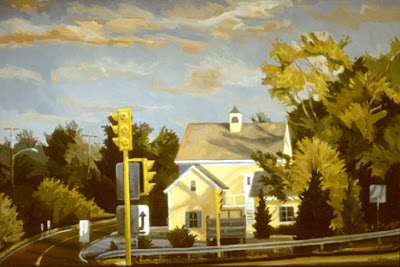A Guide for Going Back to Art School!
Philip Koch, Edward Hopper's Beach, S. Truro, MA, vine charcoal, 9 x 12", 2006
Last year about this time I wrote a short piece about teaching art students to draw and paint. Tomorrow morning I start a new semester teaching Life Drawing and Painting One at MICA. I looked up the post I wrote at the time listing some basic ideas I want to remember to get across. Reading them over, they strike me as pretty good. I added a couple of more thoughts to flesh out what I wrote back then and inserted into the list.Here's the new expanded blog post:
I teach two classes a week at the Maryland Institute College of Art in Baltimore. It's a large art school ("America's oldest continuously degree-granting College of Fine Art"). PAFA up in Philadelphia is older, but we can claim Abraham Lincoln giving his second inaugural address at MICA, which is pretty cool
Every summer brings to an end a period of intense painting activity for me, a time when I do a lot and speak little about it to others. It's my annual "monk" period. This is good for it clears my head and allows me to think afresh about what I want to say to my students on the first day of class.
This Fall I'm teaching Life Drawing and an introductory Painting class. Both are required classes and always have a few over twenty students. I love teaching these offerings because I believe they offer perhaps the greatest potential to genuinely help young artists grow. On the first day you can't descend into all the subtleties and details. Since the students' ears are working overtime on Day 1, tell them what you feel is most important.

Philip Koch, Cape Cod Morning, oil on canvas, 36 x 54", 1990
Permanent Collection of the Cedar Rapids Museum of Art
So here are the things I'm planning to say:
1. Art is a visual experience before it is anything else. Expanding your capacity to see is our goal, so we are going to give you as many opportunities to look as possible. If you look a lot, you start to see. Those are not the same thing.
1 1/2. One of the problems with art school group critiques is that the student artist is right there and able to verbally make a case for their drawing or painting. It gets one into the habit of thinking if one has something elegant or insightful sounding to say about your work you'll be OK. Well, as long as you're standing right next to your painting that's displayed on the wall, so much the better. But 99% of the time your work has to stand alone. You have to do something that purely visually grabs strangers and pulls them in.
2. While there are many competing ways of working in today's art world, no one gets anywhere by barking up every tree simultaneously. Many branches of the art world have their own validity, and we are not here to deny them that. But we are going to concentrate on just a few approaches to making art so me can make the most progress in the short time we have together.
2. While there are many competing ways of working in today's art world, no one gets anywhere by barking up every tree simultaneously. Many branches of the art world have their own validity, and we are not here to deny them that. But we are going to concentrate on just a few approaches to making art so me can make the most progress in the short time we have together.
2 1/2. Pick you best ideas out of the whole multitude of ideas that race around your head. Do as much as you can with them for a sustained time. Later, if some of those other ideas are still of interest, you can take them up down the road.
3. You have to become an expert not only on your own work, but also the progress of all your classmates. They are here so you can learn from them- how are they solving their problems? What do they routinely do well? What pot holes do they keep falling back into that you should avoid? If you
come to class and share your work, you are shouldering your responsibility of helping your fellow artists.
So you have to come to class.
4. We are going to require you to work standing up at all times. If you are standing you awaken your senses, including your eye. Artists have as much in common with dancers and athletes as we do with poets and philosphers, so we employ the whole body in our work.
5. Put your Home Studio piece up on our critique wall first thing when you enter the classroom in the morning and leave it up until the last possible moment before you leave at the end of the day. It will look different in our classroom studio than it did at home. You want as much time as possible to see what you may have overlooked. Also you want to see your work in the context of your fellow artists' pieces.
When you hang your work up, hang it with a sense of pride. There is no more important piece of art in the world for you than the one you are putting up each morning. Make sure it is level (and if it's a drawing pin it down lovingly flat with pins in at all four corners.
3. You have to become an expert not only on your own work, but also the progress of all your classmates. They are here so you can learn from them- how are they solving their problems? What do they routinely do well? What pot holes do they keep falling back into that you should avoid? If you
come to class and share your work, you are shouldering your responsibility of helping your fellow artists.
So you have to come to class.
4. We are going to require you to work standing up at all times. If you are standing you awaken your senses, including your eye. Artists have as much in common with dancers and athletes as we do with poets and philosphers, so we employ the whole body in our work.
5. Put your Home Studio piece up on our critique wall first thing when you enter the classroom in the morning and leave it up until the last possible moment before you leave at the end of the day. It will look different in our classroom studio than it did at home. You want as much time as possible to see what you may have overlooked. Also you want to see your work in the context of your fellow artists' pieces.
When you hang your work up, hang it with a sense of pride. There is no more important piece of art in the world for you than the one you are putting up each morning. Make sure it is level (and if it's a drawing pin it down lovingly flat with pins in at all four corners.
5 1/2. Inevitably there will be times when you become unhappy with your results. If you've developed the habit of taking care of your work and presenting it well, those dark periods will be shorter and less intense.
6. You must save all your work, both in class and the work you do outside of class for your Home Studio topics. Even if a piece is not successful (if you are trying to stretch your art wings you will fail some of the time) you have to absorb its lessons for you. A successful artist never "loses" her or his work, and you won't.
7. Entering into a creative frame of mind is difficult at best. The setting where you do make your drawings or paintings is critical to your success.
I like to talk about The Muse, the mythological figure who represents our deepest and most inventive side, and for convenience I call her a "she." The Muse has made it known through the years that she doesn't like to work surrounded by squalor. To get the Muse to come join you as you work you must keep your work space clean. After class you must clear up you work area, throw out your dirty rags, wrappers, recycle cans, etc. Remember, The Muse is watching. She is legendarily fickle. Do not annoy her or she won't help you with your art.

Philip Koch, Monhegan Dawn, Ochre, oil on panel, 6 1/2 x 13", 2011
6. You must save all your work, both in class and the work you do outside of class for your Home Studio topics. Even if a piece is not successful (if you are trying to stretch your art wings you will fail some of the time) you have to absorb its lessons for you. A successful artist never "loses" her or his work, and you won't.
7. Entering into a creative frame of mind is difficult at best. The setting where you do make your drawings or paintings is critical to your success.
I like to talk about The Muse, the mythological figure who represents our deepest and most inventive side, and for convenience I call her a "she." The Muse has made it known through the years that she doesn't like to work surrounded by squalor. To get the Muse to come join you as you work you must keep your work space clean. After class you must clear up you work area, throw out your dirty rags, wrappers, recycle cans, etc. Remember, The Muse is watching. She is legendarily fickle. Do not annoy her or she won't help you with your art.

Philip Koch, Monhegan Dawn, Ochre, oil on panel, 6 1/2 x 13", 2011



